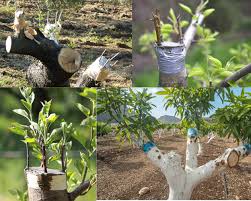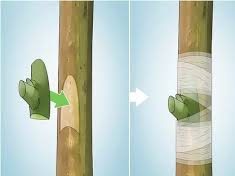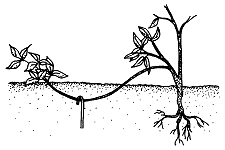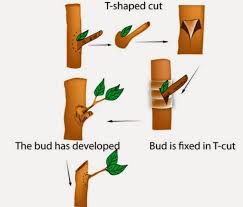Plant species are naturally endowed with the ability to regenerate themselves through self- or cross-pollination of their flowers to produce seeds. When physiologically mature, seeds germinate under optimal environments and generate new individual plants to perpetuate the parent plant.
Similarly, plant species whose seeds are not adequately viable to produce new plants and/or sterile (e.g., plantains) depend primarily on the induction of vegetative sections (leaf, stem, root, flower stalks) containing viable buds. These species are particularly vigorous in asexual propagation.
Seed propagation of crops is more ancient than asexual propagation and evolved with the origin of agricultural crop production in pre-historic times. Historically, human use of seeds marks the transition from nomadic food gathering to sedentary civilizations based on agriculture in different parts of the world.
In recent times, technological advances have led to the development of micro-propagation, which involves the culturing of individual cells or groups of cells (tissues) under highly aseptic conditions to produce whole new disease- and insect-free plants.
In this article, different types of propagation through propagules and the use of micro-cells will be discussed.
Asexual Propagation Methods (Vegetative)
This method involves the induction of a vegetative section or part of a living plant to form roots, and subsequently, developing it into a whole new plant. Plant multiplication does not involve the seed cycle (exchange of genetic materials); therefore, it is the best way to maintain some species as clones—individuals identical to the parent.
Read Also: How to Grow, Use and Care for Whitetinge Sedge Grass (Carex albicans)
Types of Propagating Materials (Propagules)

1. Seed
‘Seed’ is the generative part of the plant used for propagation. A seed is a small immature plant (embryo) protected by a seed coat or testa, formed from the outer layers of the ovule after fertilization. The seed is the basic unit of propagating many tropical crops, including yam and fruits (pawpaw, passion fruit).
Even in crop species whose primary mode of propagation is by vegetative means (e.g., mango, avocado pear), seed sowing constitutes an important method of regenerating new plants.
Seeds are sown in three different ways: by broadcasting, drilling/row-seeding, and pocket drilling/sowing in holes.
Advantages of sexual propagation include:
i. Ease of transportation of propagating materials.
ii. Less cost, skill, and work to raise seedlings.
iii. Ease of vegetative propagation in mature plants, hybrid vigor, and associated benefits of developing new varieties.
iv. Wider adaptation to varying environments.
The disadvantages of sexual propagation include:
i. Slow seedling growth.
ii. Non-prototype offspring.
iii. Problems with ensuring uniform produce quality, as most seeds originate from cross-pollination by wind or insects.
iv. Weaker seedlings.
v. Longer period to plant maturity than vegetatively propagated crop species.
2. Budding/Bud Grafting
Budding involves the engrafting of the bud (scion) of a plant into the stem (stock) of another plant of the same genus. This method is very suitable for propagating deciduous fruit trees (Citrus spp.) and shade trees.
Budding of improved materials on regenerated chupons is one of the new methods of rehabilitating cacao in Nigeria. In the most common T-budding pattern, the desired scion from a young, actively growing shoot of a chosen crop variety is immediately slid into a T-shaped slit on the rootstock.
The joined bud and rootstock are held by winding a rubber band, special tape, or wrap around them until sealed, which prevents drying or contamination of grafted materials.
Chip budding is used for species whose barks do not “slip” (easily lift in one uniform layer from the underlying wood) without tearing.
Advantages of bud grafting include:
i. Bud grafting is faster, easier, and less messy than other forms of grafting.
ii. Allows production of plants identical to a parent plant.
iii. May increase crop productivity through the superior qualities of the rootstock such as hardness, superior rooting capacity, drought tolerance, and insect or disease resistance.
Disadvantages of bud grafting include:
i. Labour-intensive.
ii. Requires great skill in nursery operations, thus expensive.
iii. Most effective when performed at specific times with optimal weather and crop physiological growth status.
The vascular cambium of both the bud scion and rootstock must align to stimulate tissue growth before rooting.
3. Grafting
This process is similar to budding but involves joining the upper part (scion wood, 0.63-1.27 cm diameter, and only with leaf buds) of one plant to the understock (rootstock) of another plant of the same species (clones, varieties).
Grafting is an ancient art and science of plant propagation, used in pears, citrus, mangoes, grapes, and other fruit trees, dating back 4000 years to ancient China and Mesopotamia. Some plants naturally graft when two branches are in close contact for several years (e.g., ivy).
Advantages of grafting include:
i. Allows production of plants identical to a parent plant.
ii. Enables control over the size and shape of a tree or shrub, such as apples.
iii. Results in more vigorous and earlier fruiting plants.
iv. Two varieties can be grown on the same tree for easier pollination, such as in apples.
Disadvantages of grafting include:
i. Labour-intensive and expensive.
ii. Inefficient in poor weather and plant growth conditions.
iii. Requires precise alignment of cambiums between scion wood and rootstock.
iv. Risks of graft incompatibility, sucker production in grafted plants, and rootstock death due to scion rooting below the ground.
Protection of the grafted area is essential to prevent dislodging of the scion, especially by bracing. There is also the risk of top growth being brittle, thus failing to harden off before cold weather.
Read Also: How to Grow, Use and Care for Whitegrass (Leersia virginica)
Reasons for Budding and Grafting

- Opportunity to change varieties or cultivars for crop improvement.
- Optimizing cross-pollination, especially in non-self-pollinating fruit trees.
- Benefits of particular rootstocks such as superior growth habits, disease and insect resistance, and drought tolerance.
- Advantages of interstocks, valuable in cases of graft incompatibility.
- To perpetuate clones by grafting onto seedling rootstocks when clones cannot be economically reproduced from vegetative cuttings, such as in conifers.
- To produce specific plant forms, for example, weeping or cascading forms like in weeping hemlock.
- To repair damaged plants due to maintenance equipment, disease, rodents, or winter storms, through arching, approach grafting, or bridge grafting.
- To increase seedling growth rates, particularly in trees that require 8–12 years to fruit naturally.
- To facilitate virus indexing by grafting scions from a plant onto another highly susceptible plant that will show symptoms of infection quickly.
Some rules for successful grafting include:
- Incompatible plants cannot be grafted.
- The cambium layers of the rootstock and scion must touch.
- The scion must be oriented correctly when grafting.
- Grafting can be done at any time of the year, but the best time for deciduous plants is when they drop their leaves and are dormant.
- Cool, cloudy days with no wind are optimal for grafting to prevent drying out.
- Care activities are crucial until the rootstock and scion are properly joined.
4. Layering
Layering involves bending a branch or part of a stem of a growing plant, anchoring it (with a rock or peg), and burying a portion of it to establish a new root system at the point of contact between the bent part and the earth (on shoots still attached to the parent plant).
A light soil increases rooting success, as does wounding or girdling the buried portion. Treatment with a rooting hormone (e.g., Rootone, HormondinR, HormonexR) is desirable, particularly one containing a fungicide.
Plants with flexible branches are especially suited to this method. Once the new plant is established, the connection with the parent plant is severed, and the new plant becomes independent.
Layering is a good propagation choice when only a few plants are needed. A heavy soil reduces rooting success, while covering the tip of the parent plant (bent shoot) kills it.
Other types of layering include serpentine/compound layering, continuous/trench layering, and mound/stool layering.
Layering of Plants and Types of Layering

i. Banking Up: Banking up is a common method for propagating pear, quince, and apple rootstock (M-type clones). This process involves cutting back the mother plant close to the surface for 2-3 years, leading to the development of a thicker root neck.
Afterward, the plant is banked up to a height of 10-15 cm when the stems reach a length of 20-25 cm. At the end of the growing season, rooted stems can be harvested.
ii. Simple Layering: This technique is typically used for hazelnut propagation. During the dormant season, stems are bent into a 20-25 cm deep trench and covered with soil. The top parts of the stems, with 2-3 buds, remain above the soil surface.
iii. Radial or Chinese Layering: In this method, the entire stem is bent down into a 10 cm deep trench and covered with soil. As the sucker grows, it is banked up regularly until about 2/3 of its height is covered with soil. This technique is mainly used for propagating gooseberries, currants, and hazelnuts.
iv. Air Layering: Air layering is typically used on younger stems, usually less than a year old. A strip of bark about 2 cm wide is removed approximately 20 cm from the tip, followed by the application of rooting hormone. A rooting material is placed under the strip, and the area is covered with a plastic bag to maintain high humidity. Litchi, guava, macadamia, and mango are commonly propagated using this method.
5. Cuttings
A cutting is a part of a plant removed from the parent to form a new plant. Cuttings regenerate through meristematic cells found at rapid growth sites like buds. Rooting hormones like auxins and cytokinins help to accelerate rooting and uniform root formation.
The main types of cuttings are stem, leaf, and root cuttings, which allow for asexual reproduction of various plant species.
The advantages of cuttings include quick and efficient propagation of genetically identical clones, though some disadvantages are that not all plants can be propagated from cuttings, and the cuttings must be carefully prepared and shielded from direct sunlight.
Types of Cuttings
1. Stem Cuttings: Commonly used for woody ornamental plants and food crops like sweet potato and cassava. Stem cuttings can be from herbaceous, softwood, semi-hardwood, or hardwood stems, with the type of stem influencing rooting success. Softwood cuttings require high humidity and care in handling, while hardwood cuttings, taken from mature plants, are often used for deciduous shrubs.
2. Leaf Cuttings: Used for indoor plants that form adventitious buds, such as African violets and pepperoni. Methods include whole-leaf cuttings (with or without petiole), split-vein cuttings, and leaf-bud cuttings, all of which promote the growth of new plants from the cut leaves.
3. Root Cuttings: Involves propagating plants from sections of roots, commonly used for species like blackberry and rose. Root cuttings are typically taken during the dormant season for woody plants or throughout the growing season for other species.
4. Micropropagation or Tissue Culture: This advanced propagation method involves growing a plant from a small piece of tissue in a sterile medium. It is used for mass propagation of crops like sugarcane and sweet potatoes. The technique allows for the production of disease-free plants but requires very strict environmental conditions and can lead to spontaneous mutations.
Plants reproduce either sexually or asexually, depending on the crop’s suitability for either method. Sexual reproduction promotes genetic diversity, while asexual reproduction ensures true-to-type plants.
Various asexual propagation methods, including layering, cuttings, and tissue culture, are used to efficiently produce large quantities of genetically identical plants.
Do you have any questions, suggestions, or contributions? If so, please feel free to use the comment box below to share your thoughts. We also encourage you to kindly share this information with others who might benefit from it. Since we can’t reach everyone at once, we truly appreciate your help in spreading the word. Thank you so much for your support and for sharing!

